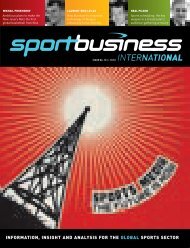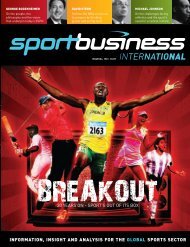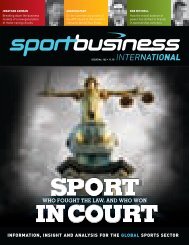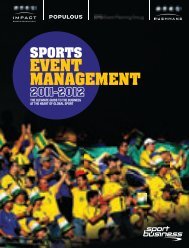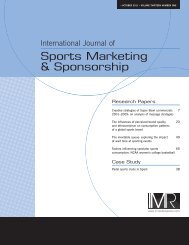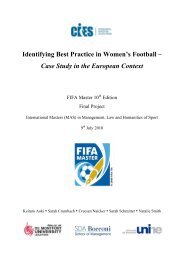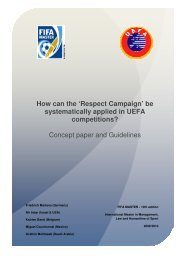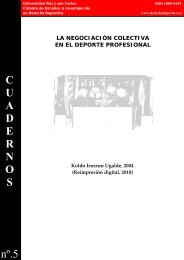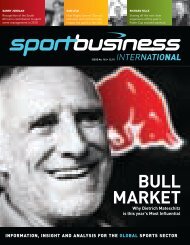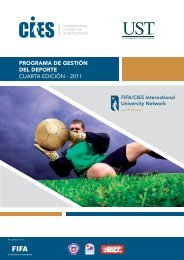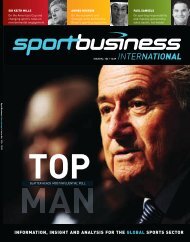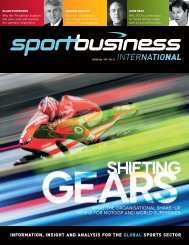Sports Marketing & Sponsorship - FIFA/CIES International University ...
Sports Marketing & Sponsorship - FIFA/CIES International University ...
Sports Marketing & Sponsorship - FIFA/CIES International University ...
- No tags were found...
Create successful ePaper yourself
Turn your PDF publications into a flip-book with our unique Google optimized e-Paper software.
Can sponsorships be harmful for events?RESEARCH PAPERliterature discussed shows that a transfer ofassociations from the sponsor to the event should bepossible. This results in the following hypothesis:H1: If a sponsoring brand is linked to an eventthrough sponsorship, some of the associationswith the sponsoring brand will be transferred tothe image of the event in people’s minds.In keeping with the recommendation of Rossiter(2002), we would like to clarify the terminology of‘image transfer’ and ‘transfer of associations’. Itappears that these terms are often usedinterchangeably (Gwinner & Eaton, 1999;Meenaghan, 2001; Gwinner, 1997) or without a clearenough distinction between the two. In line with theassociative network memory model, one can arguethat these two concepts are not the same. Keller(1993, p.3) defines brand image as “perceptionsabout a brand as reflected by the brand associationsheld in memory”. So the image of an object containsall of the collected brand associations a person haswith that object. If the term ‘image transfer’ is beingused, this implies that in the case of a transfer, theimage as a whole will be transferred instead of singlebrand association. A complete or full image transfer isnot very likely to occur for two main reasons. First, animage contains many kinds of associations, namely:(1) product-related or non-product-related attributes,(2) functional, experiential or symbolic benefits, and(3) overall brand attitudes (Keller, 1993).It seems impossible, although not yet proven byresearch, that sponsorship can cause a transfer of allthree kinds of associations at once. Although weacknowledge that extremely effective sponsorshipprogrammes probably do transfer many associations,we doubt that there are many instances of full imagetransfer. Secondly, the associations can differ in theirdegree of favourability, strength and uniqueness(Keller, 1993).MethodologyAccording to Cornwell et al (2005), there is a need formore experimental research to improve theunderstanding of processing mechanisms ofsponsorship communication. As our research questionis not only related to a relationship between twovariables but also questions the direction of theinfluence, a causal research design was selected.In principle, any respondent group can be used totest a universal theory; however, characteristics of thegroup chosen are interrelated with theoperationalisations of theory variables (Calder et al,1981). We strived for a homogeneous yet relevantsubgroup, and decided upon a student sample. Inorder to avoid the possibility of Type II errors, wefollowed Ferber’s (1977) recommendation to employoperationalisations that are relevant for the subjectpopulation. We identified snowboarding as a contextwhich for students had significant relevance, interestand participation.A post-test-only experimental design was utilised, inwhich we altered the sponsoring brand but kepteverything else constant. We prepared two newspaperarticles about a fictitious snowboarding event, whichwere almost identical, differing only in the brand thatwas mentioned as the key sponsor. Our experimentresembles the approach taken by Gwinner and Eaton(1999). A pre-test among 33 students was conductedin order to identify the most important associationspertaining to a snowboarding event as well as to selectthe sponsoring brands to be used for creating thecontrasting stimuli.Two brands were selected based on their strongprofile and their expected divergent contrasts in termsof elicited associations. The first brand, Quiksilver, is awinter sporting goods manufacturer and likely to havemany complementary associations in reference to theevent. The second brand, telecommunications providerKPN, was chosen in the belief that it did not have asstrong a complementary association fit with the event.In all, 112 undergraduate business administrationstudents participated in the experiment. The248 <strong>International</strong> Journal of <strong>Sports</strong> <strong>Marketing</strong> & <strong>Sponsorship</strong> ● APRIL 2009 ●



